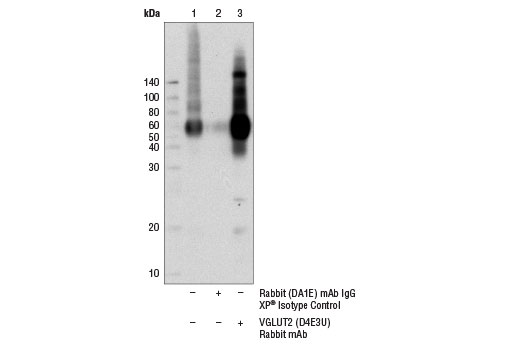WB, IP
H M R
Endogenous
65-70
Rabbit IgG
#Q9P2U8
57084
Product Information
Product Usage Information
| Application | Dilution |
|---|---|
| Western Blotting | 1:1000 |
| Immunoprecipitation | 1:50 |
Storage
Specificity / Sensitivity
Species Reactivity:
Human, Mouse, Rat
Source / Purification
Monoclonal antibody is produced by immunizing animals with a synthetic peptide corresponding to residues near the amino terminus of human VGLUT2 protein.
Background
Glutamatergic neurons release glutamate, the most common excitatory neurotransmitter. Their synaptic vesicles are filled with glutamate by vesicular glutamate transporters, VGLUTs (1). VGLUT1, also called solute carrier family 17 member 7 (SLC17A7), was first identified as an inorganic phosphate transporter (2). Despite the absence of homology with neurotransmitter transporters, VGLUT1 was later demonstrated to be a glutamate transporter (1) specific to glutamatergic neurons (3). Closely related to VGLUT1, VGLUT2 and VGLUT3 are also involved in glutamate uptake into synaptic vesicles, but define different neuronal subpopulations (4,5). VGLUT1 and VGLUT2 are the most abundant isoforms. VGLUT1 is expressed in the cortex, hippocampus, and cerebellar cortex, while VGLUT2 is mostly found in the thalamus (6,7). VGLUT3 is expressed in hair cells of the auditory system (8).
- Bellocchio, E.E. et al. (2000) Science 289, 957-60.
- Ni, B. et al. (1996) J Neurochem 66, 2227-38.
- Takamori, S. et al. (2000) Nature 407, 189-94.
- Fremeau, R.T. et al. (2001) Neuron 31, 247-60.
- Fremeau, R.T. et al. (2002) Proc Natl Acad Sci U S A 99, 14488-93.
- Herzog, E. et al. (2001) J Neurosci 21, RC181.
- Kaneko, T. and Fujiyama, F. (2002) Neurosci Res 42, 243-50.
- Seal, R.P. et al. (2008) Neuron 57, 263-75.
Species Reactivity
Species reactivity is determined by testing in at least one approved application (e.g., western blot).
Western Blot Buffer
IMPORTANT: For western blots, incubate membrane with diluted primary antibody in 5% w/v nonfat dry milk, 1X TBS, 0.1% Tween® 20 at 4°C with gentle shaking, overnight.
Applications Key
WB: Western Blotting IP: Immunoprecipitation
Cross-Reactivity Key
H: human M: mouse R: rat Hm: hamster Mk: monkey Vir: virus Mi: mink C: chicken Dm: D. melanogaster X: Xenopus Z: zebrafish B: bovine Dg: dog Pg: pig Sc: S. cerevisiae Ce: C. elegans Hr: horse GP: Guinea Pig Rab: rabbit All: all species expected
Trademarks and Patents
Limited Uses
Except as otherwise expressly agreed in a writing signed by a legally authorized representative of CST, the following terms apply to Products provided by CST, its affiliates or its distributors. Any Customer's terms and conditions that are in addition to, or different from, those contained herein, unless separately accepted in writing by a legally authorized representative of CST, are rejected and are of no force or effect.
Products are labeled with For Research Use Only or a similar labeling statement and have not been approved, cleared, or licensed by the FDA or other regulatory foreign or domestic entity, for any purpose. Customer shall not use any Product for any diagnostic or therapeutic purpose, or otherwise in any manner that conflicts with its labeling statement. Products sold or licensed by CST are provided for Customer as the end-user and solely for research and development uses. Any use of Product for diagnostic, prophylactic or therapeutic purposes, or any purchase of Product for resale (alone or as a component) or other commercial purpose, requires a separate license from CST. Customer shall (a) not sell, license, loan, donate or otherwise transfer or make available any Product to any third party, whether alone or in combination with other materials, or use the Products to manufacture any commercial products, (b) not copy, modify, reverse engineer, decompile, disassemble or otherwise attempt to discover the underlying structure or technology of the Products, or use the Products for the purpose of developing any products or services that would compete with CST products or services, (c) not alter or remove from the Products any trademarks, trade names, logos, patent or copyright notices or markings, (d) use the Products solely in accordance with CST Product Terms of Sale and any applicable documentation, and (e) comply with any license, terms of service or similar agreement with respect to any third party products or services used by Customer in connection with the Products.

